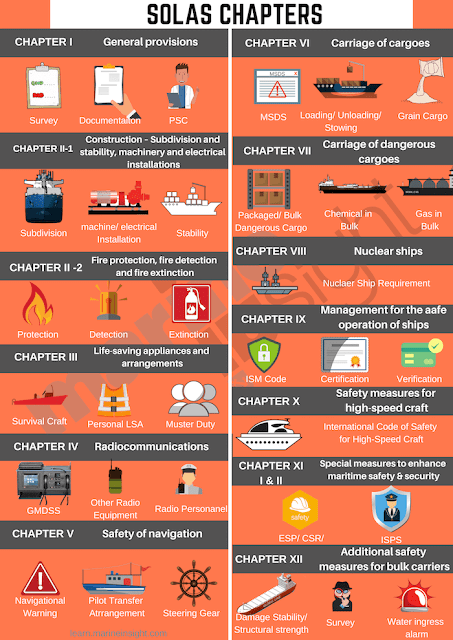The maritime industry’s most important concerns are the safety of personnel and prevention of marine pollution for smooth cargo transportation and marine operation at high seas. To achieve this, the International Maritime Organization (IMO) relies on its four very strong pillars: SOLAS, MARPOL, STCW and MLC.
SOLAS
The International Convention for the Safety of Life at Sea (SOLAS) is an international maritime treaty which sets minimum safety standards in the construction, equipment and operation of merchant ships. The convention requires signatory flag states to ensure that ships flagged by them comply with at least these standards.
The current version of SOLAS is the 1974 version, known as SOLAS 1974, which came into force on 25 May 1980. As of November 2018, SOLAS 1974 had 164 contracting states, which flag about 99% of merchant ships around the world in terms of gross tonnage.[1]
SOLAS in its successive forms is generally regarded as the most important of all international treaties concerning the safety of merchant ships.
- Chapter I – General Provisions
- Surveying the various types of ships and certifying that they meet the requirements of the convention.
- Chapter II-1 – Construction – Subdivision and stability, machinery and electrical installations
- The subdivision of passenger ships into watertight compartments so that after damage to its hull, a vessel will remain afloat and stable.
- Chapter II-2 – Fire protection, fire detection and fire extinction
- Fire safety provisions for all ships with detailed measures for passenger ships, cargo ships and tanker.
- Chapter III – Life-saving appliances and arrangements
- Life-saving appliances and arrangements, including requirements for life boats, rescue boats and life jackets according to type of ship. The specific technical requirements are given in the International Life-Saving Appliance (LSA) Code.
- Chapter IV – Radiocommunications
- The Global Maritime Distress Safety System (GMDSS) requires passenger and cargo ships on international voyages to carry radio equipment, including satellite Emergency Position Indicating Radio Beacons (EPIRBs) and Search and Rescue Transponders (SARTs).
- Chapter V – Safety of navigation
- This chapter requires governments to ensure that all vessels are sufficiently and efficiently manned from a safety point of view. It places requirements on all vessels regarding voyage and passage planning, expecting a careful assessment of any proposed voyages by all who put to sea. Every mariner must take account of all potential dangers to navigation, weather forecasts, tidal predictions, the competence of the crew, and all other relevant factors. It also adds an obligation for all vessels' masters to offer assistance to those in distress and controls the use of lifesaving signals with specific requirements regarding danger and distress messages. It is different from the other chapters, which apply to certain classes of commercial shipping, in that these requirements apply to all vessels and their crews, including yachts and private craft, on all voyages and trips including local ones.
- Chapter VI – Carriage of Cargoes
- Requirements for the stowage and securing of all types of cargo and cargo containers except liquids and gases in bulk.
- Chapter VII – Carriage of dangerous goods
- Requires the carriage of all kinds of dangerous goods to be in compliance with the International Bulk Chemical Code (IBC Code), The International Code of the Construction and Equipment of Ships Carrying Liquefied Gases in Bulk (IGC Code) and the International Maritime Dangerous Goods Code (IMDG Code).
- Chapter VIII – Nuclear ships
- Nuclear powered ships are required, particularly concerning radiation hazards, to conform to the Code of Safety for Nuclear Merchant Ships.
- Chapter IX – Management for the Safe Operation of Ships
- Requires every shipowner and any person or company that has assumed responsibility for a ship to comply with the International Safety Management Code (ISM).
- Chapter X – Safety measures for high-speed craft
- Makes mandatory the International Code of Safety for High-speed craft (HSC Code).
- Chapter XI-1 – Special measures to enhance maritime Safety
- Requirements relating to organizations responsible for carrying out surveys and inspections, enhanced surveys, the ship identification number scheme, and operational requirements.
- Chapter XI-2 – Special measures to enhance maritime security
- Includes the International Ship and Port Facility Security Code (ISPS Code). Confirms that the role of the Master in maintaining the security of the ship is not, and cannot be, constrained by the Company, the charterer or any other person. Port facilities must carry out security assessments and develop, implement and review port facility security plans. Controls the delay, detention, restriction, or expulsion of a ship from a port. Requires that ships must have a ship security alert system, as well as detailing other measures and requirements.
- Chapter XII – Additional safety measures for bulk carriers
- Specific structural requirements for bulk carriers over 150 metres in length.
- Chapter XIII - Verification of compliance
- Makes mandatory from 1 January 2016 the IMO Member State Audit Scheme.
- Chapter XIV - Safety measures for ships operating in polar waters
- The chapter makes mandatory, from 1 January 2017, the Introduction and part I-A of the International Code for Ships Operating in Polar Waters (the Polar Code)




No comments:
Post a Comment